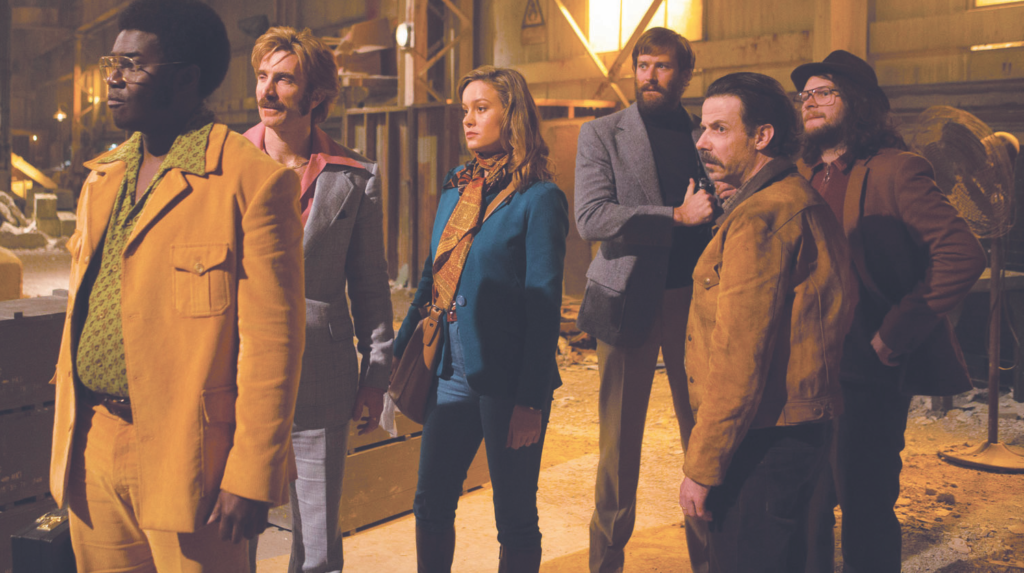
The exposition for “Free Fire” almost sounds like the start of a contrived joke: a couple of Irish Republican Army members, a few junkies and a handful of egotistical gunrunners walk into an abandoned umbrella factory. The events that follow are, perhaps appropriately, quite funny. The film, directed by Ben Wheatley and starring a cavalcade of stars including Brie Larson, Armie Hammer, Cillian Murphy and Sharlto Copley, is a cynical, but none-too-serious comedy of errors, packed with the stylized bloodiness of Quentin Tarantino and the absurd wryness of “Monty Python.”
“Free Fire” is, in its best moments, a self-aware, fun movie about selfish imbeciles whom the audience is compelled to perpetually root both for and against.
When Chris (Murphy) and Frank (Michael Smiley), two no-nonsense Irish revolutionaries, walk into the old factory accompanied by bumbling stooges Bernie and Stevo (Enzo Cilenti and Sam Riley) and two professional intermediaries, Justine (Larson) and Ord (Hammer), the plan seems simple enough: the Irishmen bring the money and the dealers bring the guns. However, when the gunrunners, led by the comically vain Vernon (Copley), present the wrong weapons to their buyers, tensions rise. Then one of Vernon’s own cronies, Harry (Jack Reynor) recognizes Stevo as the junkie who attacked his cousins, and shots are fired.
What follows for the remaining 70 or so minutes of film is cinematic and comedic gold: a frantic shootout between a set of equally flawed and idiosyncratic personalities. The warehouse becomes a sort of paintball course with all-too-real consequences; everyone is shooting, everyone is likely to be shot and everyone either wants to escape or to nab the suitcase full of cash (brought by Chris and Frank to buy the guns) laying in the middle of the room.
The movie’s writing, which had previously been packed with flat dialogue and heavy exposition, comes into its own in the film’s gleefully violent second act. Ord’s lackadaisical quipping and pot-smoking mid-firefight, Chris and Vernon’s desperate attempts to flirt with Justine while shooting at each other and Harry and Stevo’s crack-fueled feud all quickly unravel not into a melodrama, but into a dark and bloody comedy, featuring punchlines punctuated by bullets.
However, the dialogue of a movie like “Free Fire” would matter little without a talented cast, and the film’s ensemble of morons is portrayed superbly. The low-level henchmen Stevo and Harry are both played delightfully by Cilenti and Reynor, who imbue the characters with their own respective brands of deranged mania. Hammer as the perpetually-amused Ord is almost relaxing in his aloofness, and Larson as the rightfully irritable Justine often reflects the mindset of the audience (although she’s burdened with some of the worst lines in the film). The standout performance, however, is Copley’s Vernon, a hypocrite who manages to be both constantly aggrieved and carelessly inflammatory. Vernon is a bundle of false machismo, insecurity and knee-jerk reactions, all filtered through Copley’s delightful South African accent. The characters of “Free Fire” are easy to both hate and love, a dynamic that plays perfectly in a movie where everyone has it out for everyone.
With characters like these, the plot of the film, for the most part, feels secondary. The most laughable and irony-packed moments of “Free Fire” are its most genuine and enjoyable. Whenever the script, penned by Amy Jump and director Wheatley, takes a swing at genuine poignancy or machismo, it falls flat; the nihilistic banter and idiotic attempts at victory by all of the key characters come across as what “Free Fire” is really all about. A few twists, including the brief introduction of a few outside intruders to the brawl, serve to poke the pace of the film along, but it does not particularly benefit from this added suspense. The audience learns very early on that the film’s central themes are sex, blood, money and fun. Any moments trying to convince viewers otherwise feel wasteful.
The cinematography of “Free Fire” is, for the most part, simple. The best images come in the darker moments towards the end of the second act, which features a creative use of color and lighting. However, the real mastery of the film is not in the camerawork, but in the editing, which is remarkably adept at establishing rapidly-shifting spatial relationships throughout the warehouse. The cuts of “Free Fire” are in many instances, as necessary to the film’s humor as the script is, tying together the witticisms and pleas of the film’s desperate scumbags.
“Free Fire” is one in a recent chain of cognizant, unassuming action flicks, and it serves as a prime example of what a post-modern shootout movie can be. The characters of the film are not particularly compelling, but not because they are incorrectly written; the two gangs are portrayed as simple, mostly bad people with simple, mostly bad motives.
As long as the viewer can accept this predicate early in the film, then they should have no trouble enjoying the absurdly, violently wonderful fun that is “Free Fire.”
